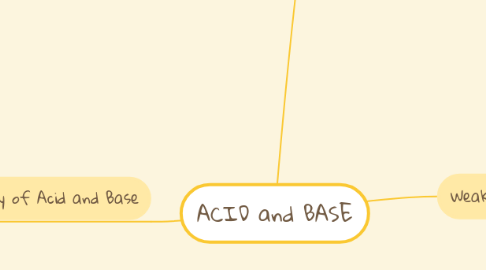
1. Theory of Acid and Base
1.1. The Water or Arrhenius
1.1.1. Definition
1.1.1.1. Acid
1.1.1.1.1. Substance that dissociates in water to form H+ ions.
1.1.1.2. Base
1.1.1.2.1. Substance that dissociates in water to form OH− ions.
1.1.2. Restrict
1.1.2.1. Substance must dissociates in water
1.1.2.2. Without H + OH-, acid-base can’t be explained.
1.2. The Proton or Bronsted-Lowry
1.2.1. Definition
1.2.1.1. Acid
1.2.1.1.1. Substance that can release a proton
1.2.1.2. Base
1.2.1.2.1. Dubstance that can accept a proton.
1.2.2. Conjugate Acids and Base pairs
1.2.2.1. Acid is a proton donor and a base is a proton acceptor. Once an acid has given up a proton, the remaining part can be a proton acceptor, and thus a base.
1.2.2.1.1. Example
1.2.2.2. Conjugate acid have more H+ than Conjugate base. (1)
1.2.3. Restrict
1.2.3.1. Substances without H + can’t be described as acids or bases.
1.3. The Electron or Lewis
1.3.1. Definition
1.3.1.1. Acid
1.3.1.1.1. Substance that can accept a pair of electrons.
1.3.1.2. Base
1.3.1.2.1. Substance that can donate a pair of electrons.
1.3.2. Restrict
1.3.2.1. Need to know the structure
2. Strength of Acid and Base
2.1. Strong Acid
2.1.1. Definition
2.1.1.1. Strong electrolytes that ionize completely in water
2.1.1.1.1. Example
2.2. Strong Base
2.2.1. Definition
2.2.1.1. Strong electrolytes that ionize completely in water
2.2.1.1.1. Example
2.3. Formula
2.3.1. Mol = g/M.W. = CV/1,000
2.3.1.1. When
2.3.1.1.1. g = Weight of substance (gram)
2.3.1.1.2. M.W. = Molecular weight
2.3.1.1.3. C = Connentration (mol/dm3)
2.3.1.1.4. V = Volume of substance (cm3)
2.3.2. C1V1 =! C2V2
2.3.2.1. When
2.3.2.1.1. C1 = Connentration of sol. before adding water
2.3.2.1.2. V1 = Volume to sol. before adding water
2.3.2.1.3. C2 = Connentration of sol. after adding water
2.3.2.1.4. V2= Volume to sol. After adding water
3. Weak Acid and Weak Base
3.1. Waek Acid
3.1.1. Ionize only to a limited in water
3.1.1.1. Example
3.1.1.1.1. HCI (aq) + H2O (l) → H3O+ (aq) + CI- (aq)
3.2. Waek Base
3.2.1. Ionize only to a limited in water
3.2.1.1. Example
3.2.1.1.1. O2- (aq) + H2O (l) → 2OH- (aq)
